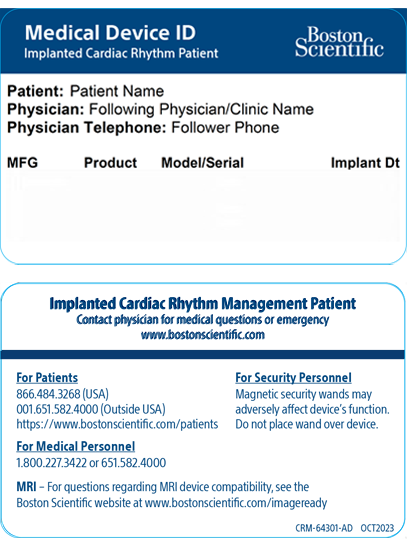What to expect from recovery
A full recovery from a CRT procedure can take a few days or a few months. You can find some general recovery tips below, but be sure to follow your doctor's post-operative instructions and talk to him or her about resuming normal activities based on your specific situation.

Post-recovery guidelines
After your procedure, be sure to ask your doctor any questions you may have about your device, heart rhythm, or medication. After your procedure, your healthcare team will give you post-operative directions, which may include:
- Avoiding activities that involve heavy lifting or rough contact that could result in blows to your implant site and to allow your incision time to heal
- Contacting your doctor if you have any swelling, redness or discharge around your incision, or if you notice anything unusual or unexpected, such as developing a fever that does not go away in 2 or 3 days
- Notifying your doctor if you hear any beeping sounds from your device as this indicates your device needs to be checked immediately
- Carry your Medical Device ID Card with you at all times
- Keep tight clothing and jewelry away from the skin over your device
- Avoid rubbing your device or the surrounding chest area
- Follow your doctor’s instructions for exercise and bathing
Activities and exercises
Your doctor will help you decide what level of activity is best for you. Some general guidelines include avoiding:
- Strenuous activity, especially lifting and other activities that use your upper body. This will give the incision where the CRT device was implanted time to heal and the leads time to firmly attach to your heart tissue
- Rough contact that could result in blows to your implant site
- Lifting heavy objects until instructed by your doctor
- Arm movements that could affect your lead system as directed by your doctor
Driving after CRT surgery
Whether you’re able to drive once you have a CRT device will depend on the driving laws where you live and your specific symptoms, such as passing out prior to the implant. Generally, having a CRT-D or CRT-P device does not prohibit you from driving. However, you may be asked to wait to drive during the early stage of recovery. In some cases, restrictions are necessary. That’s because a few seconds of unconsciousness could be dangerous to both you and others. Your health care team will discuss any driving restrictions with you.
Whether you’re a driver or passenger, you may want to find padding to cover your surgery site and make wearing a seatbelt more comfortable. You may find pads in local retail stores that will provide comfort for your pocket site.
Medical device ID card
Whether you’re going away for the weekend or running a quick errand, it’s important to carry your Medical Device Identification Card with you at all times. Your Medical Device ID Card contains your name, your doctor’s name and phone number, and the model numbers of your device and leads. In an emergency, the card will alert medical and security personnel that you have an implanted device. You will be given a temporary Medical Device ID Card when you receive your CRT device. Your permanent card will be mailed to your home approximately 6 to 8 weeks after your implant.

Moving or selecting a new doctor
Please tell us if you move or get a new doctor. You can use our online patient portal or call us at 1-800-728-3282 to update your record and we will send you a new ID card.
Regular follow-up visits
It’s important to maintain all follow-up visits, even if you’re feeling well. These appointments will help your doctor check your CRT device and overall health on a regular basis.
A typical follow-up appointment takes about 20 minutes. During your visit, your doctor or nurse will use a programmer to check your device. They will examine your CRT device’s memory, evaluate how much energy is left in your battery and check to see if you had any arrhythmia episodes since your last visit. If necessary, they will adjust your device’s programmed settings.
When to call a doctor
Your doctor will provide guidelines for when you should contact him or her. In general, call your doctor if you:
- Notice anything unusual or unexpected, such as new symptoms or symptoms like the ones you experienced before you received your device
- Have any redness, swelling, or drainage from your incisions
- Start a fever that does not go away in two or three days
- Receive any arrhythmia therapy from your device and have been instructed to call
- Develop symptoms of an abnormal heart rhythm and have been instructed to call
- Hear any beeping sounds from your device. This indicates that your device needs to be checked immediately. Listen to the sound.
- Have questions about your device, heart rhythm, or medications
- Plan to travel or move so you can work with your doctor to develop a follow-up plan while you are away